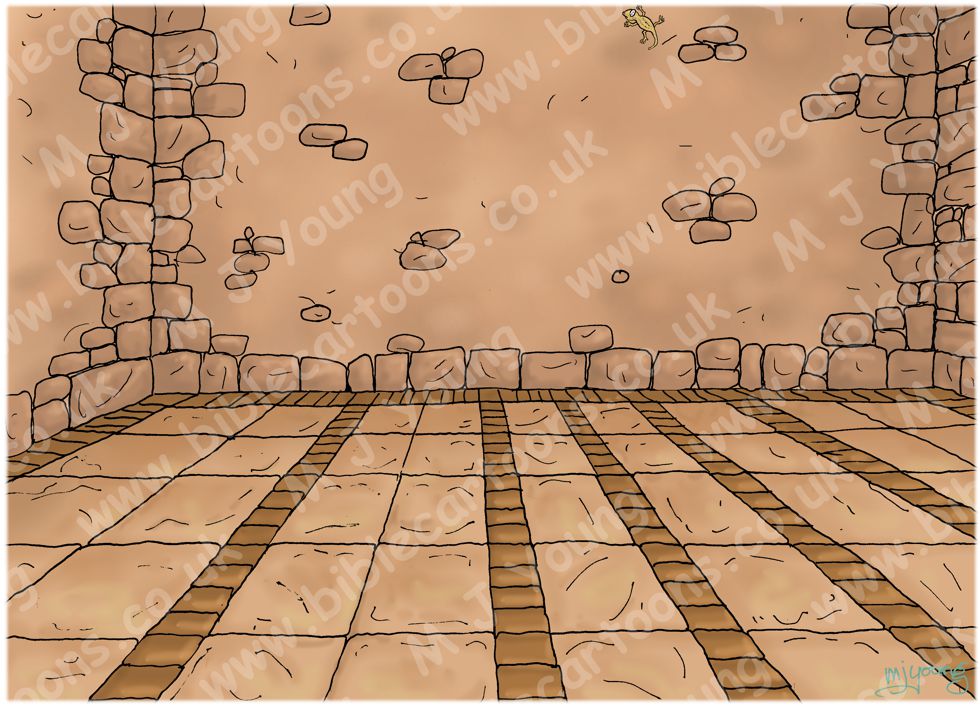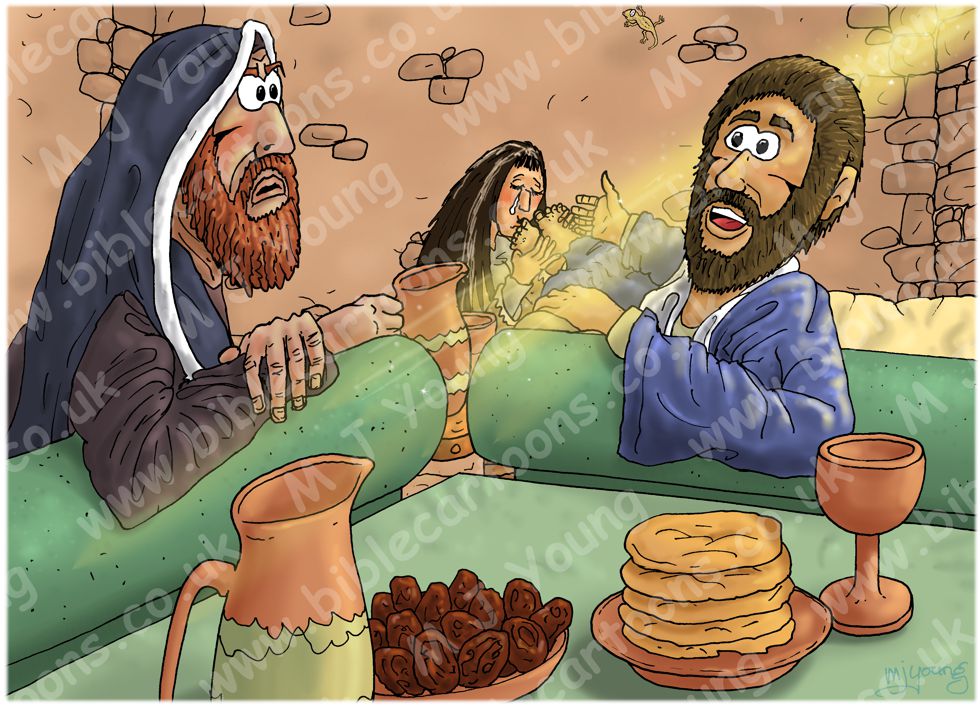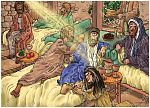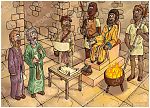Bible Cartoon: Luke 07 - Jesus anointed by sinful woman - Scene 02 - Simon's disdain
Click on Add to cart button below shopping cart.
Purchased Bible Cartoons do not have watermarks. Links to Cartoons provided on email once purchase is completed.Bible Book: Luke
Bible Book Code: 4200703901
Scene no: 2 of 4
Bible Reference & Cartoon Description
Luke 7:39-40 (ANIV)
39 When the Pharisee who had invited him saw this, he said to himself, “If this man were a prophet, he would know who is touching him and what kind of woman she is—that she is a sinner.”
40 Jesus answered him, “Simon, I have something to tell you.”
“Tell me, teacher,” he said.
DRAWING NOTES:
TIME OF DAY:
Unspecified in the Bible narrative. I have set this scene at noon.
LIGHTING NOTES:
Sunlight illuminates this scene, coming into the large courtyard room through a hole in the ceiling above the fig tree and through small windows high in the walls. The light casts shadows below the figures and objects in this scene.
CHARACTERS PRESENT:
Jesus (in blue outer robe), Simon a Pharisee (in dark blue outer robe and head scarf), the sinful woman (at Jesus’ feet).
A Gecko lizard on the wall.
RESEARCH/ADDITIONAL NOTES:
Like the previous scene, this picture is set in the home of Simon the Pharisee. In this scene we are viewing the figures and room from the stand point of the servant who has just put a plate of flat breads onto the table. The view is towards the back of the room, with Jesus on the right and Simon on the left (the reverse of the previous picture).
Here is the scene without the figures.

Background of Luke 07 – Jesus anointed by sinful woman – Scene 01 – Simon’s disdain
Click on the colour bar below to view/buy this Background:
Background of Luke 07 – Jesus anointed by sinful woman – Scene 02 – Simon’s disdain
The Pharisee Simon’s disdain (defined as the feeling that someone or something is unworthy of one’s consideration or respect) of Jesus stemmed from a combination of jealousy, fear, and a belief that Jesus was a threat to the Pharisee’s power and religious authority. They were jealous of Jesus’ popularity among the people he mixed with, and threatened by his challenge to their authority. Jesus’ words and actions angered the Pharisees because they saw him breaking what they considered to be essential religious laws, particularly not working on the Sabbath day of rest. This led to spiritual arrogance among the Pharisees, as they believed their meticulous interpretation and adherence to the law set them above the common people and others who did not meet their strict standards. Jesus did not behave as the Pharisees believed he should! But, in fact, that was due to Jesus’ grace and mercy, which strikingly contrasted with the Pharisees’ narrow-mindedness and arrogance.
The lizard on the wall is Mediodactylus kotschyi (aka Kotschy’s gecko) which is a species of gecko, in the family Gekkonidae. The species is native to southeastern Europe and the Middle East. It is named in honour of the Austrian botanist and explorer Theodor Kotschy. Its typical habitat is cliffs, dry stony areas, scrub, tree trunks, stone walls, and the external and internal walls of buildings. It is found at elevations of up to 5,577 ft (1,700 m) but is mostly a lowland species. Kotschy’s gecko is mainly nocturnal but at cooler times of year it is often active in the day as well, especially early and late. It climbs very well despite having no adhesive pads, but spends less time on cliffs and climbs less high than the wall lizards (Podarcis) spp., with which it is often found. Kotschy’s gecko is mostly distributed along the coastal areas of the Eastern Mediterranean Sea and the Black Sea. It is native to Ukraine (Crimean Peninsula), Bulgaria, Serbia, North Macedonia, Albania, Greece, Cyprus, Turkey, Syria, Lebanon, Jordan, Israel and Southern Italy (Apulia).





